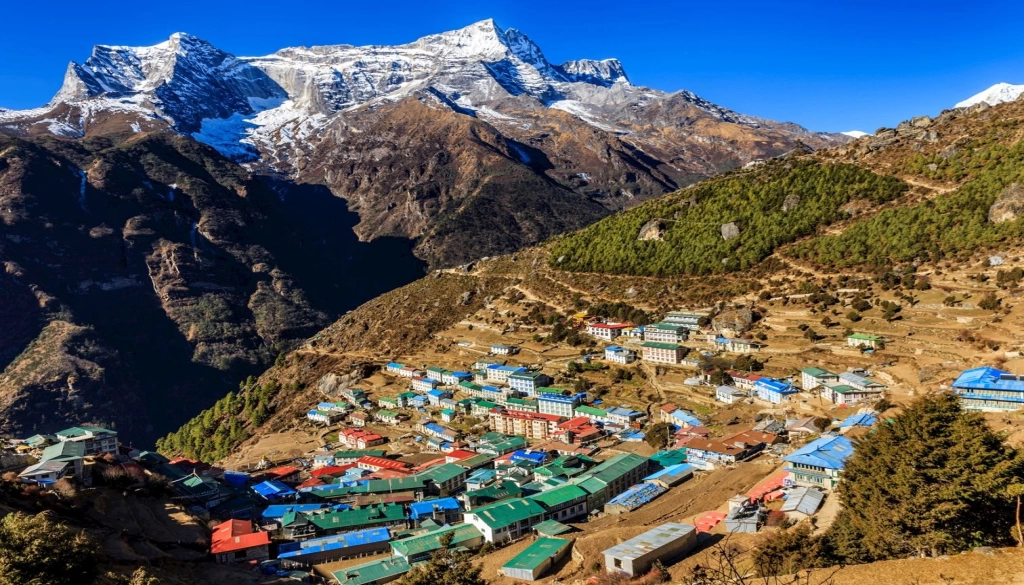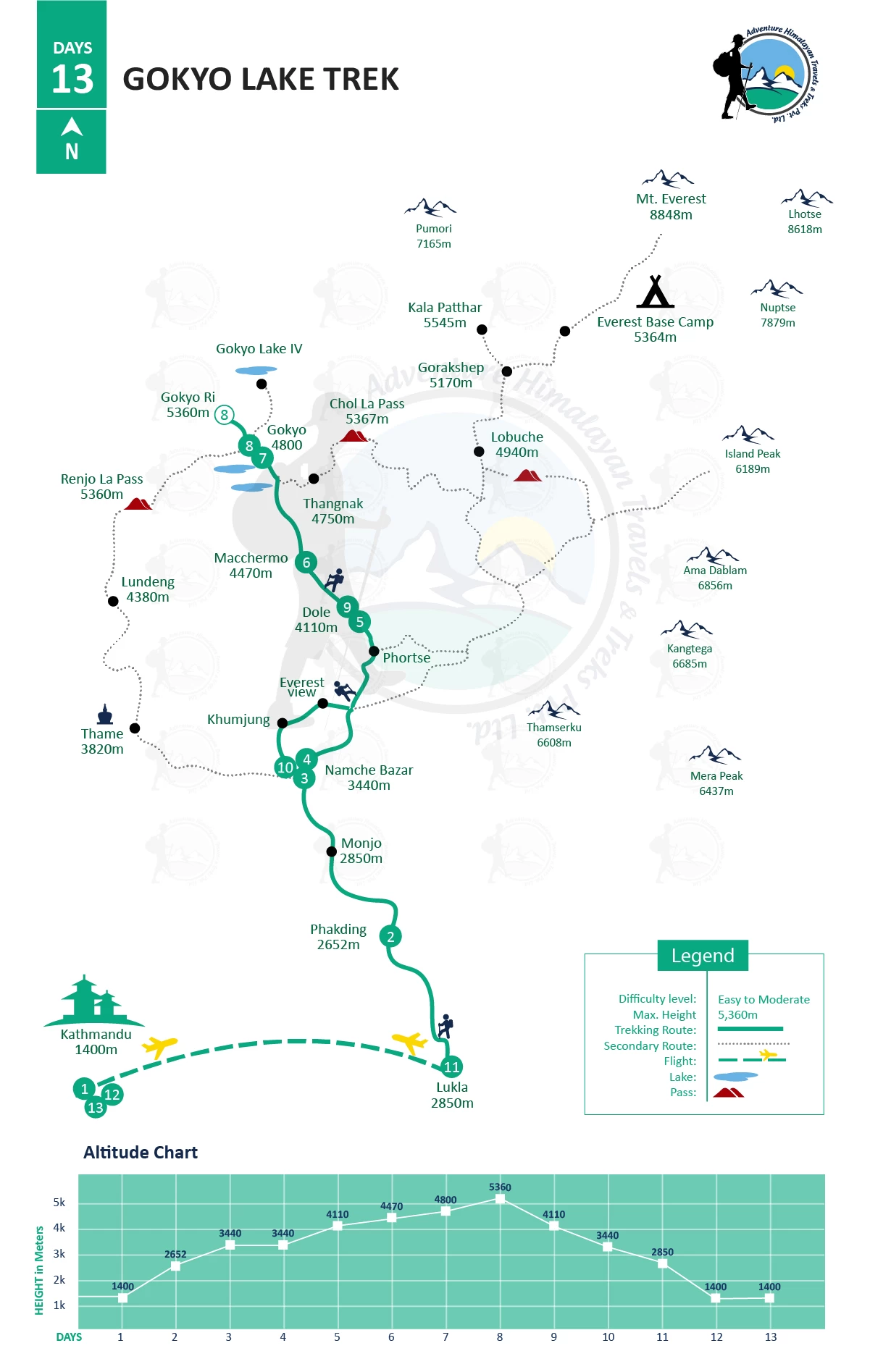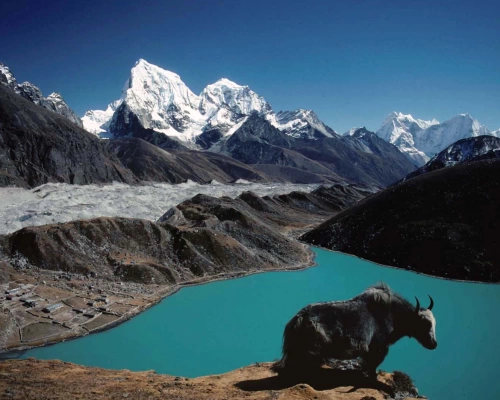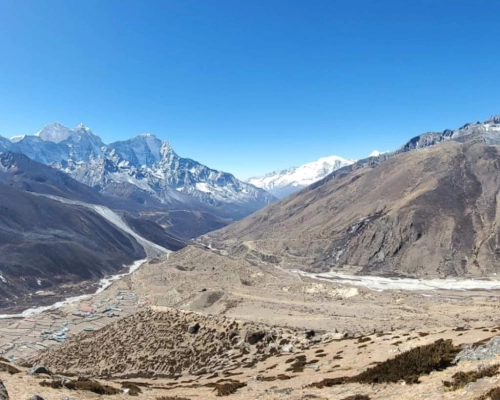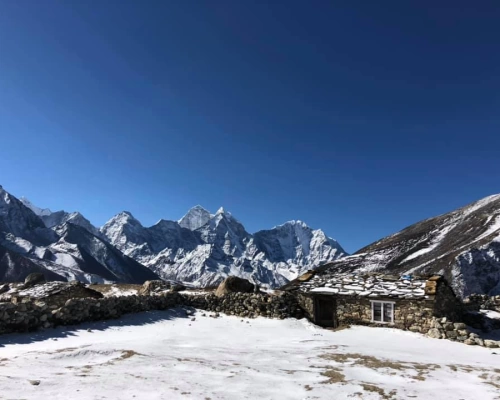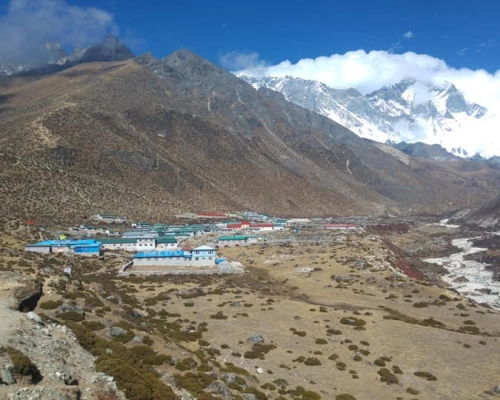The Gokyo Lake Trek is one of the less traveled routes in the Everest region that leads you to the impeccably clean, emerald-like group of six hidden lakes. The trekking trail to these freshwater wetlands is comparatively more off-beaten alpine rambling than that of Everest Base Camp and Kala Patthar, as well as several other Himalayan jaunts such as that to Annapurna Base Camp, Annapurna Circuit Trek, and others.
Lying at an elevation ranging from an altitude of about 4,700 to 5,000 m above sea level, Gokyo Lakes are fed by the high-altitude glaciers that deliver a great sense of the wonderful creation of nature and the ultimate satisfaction of stillness, clarity, and tranquility that soothe your soul upon finally ascending to the glistening Gokyo Lakes in the lap of gigantic snow-capped peaks.
Although initially the Gokyo Lake Trek follows the classic route to the Everest Base Camp Trekking in the Khumbu region of Nepal, it takes you through a relatively less traversed trackway right on Namche Bazaar onward to see the serene turquoise lakes, the beauty of the Himalayas, and allure of the longest glacier in the Nepalese Himalayas, Ngozumpa Glacier, most preferred by true expeditors seeking mostly empty and unspoiled Himalayan beauty to explore and appreciate.
Starting from Lukla following the Dudh Koshi River Valley, passing via numerous picturesque Sherpa villages like Phakding, Namche Bazaar (the bustling trade hub of the Khumbu region), Dole, and Macchermo, allocating a day of acclimatization in Namche means you get to adjust to the high altitude with a low level of oxygen; hence, the trek to Gokyo Lake offers a balanced challenge that you can overcome, rewarding you equally.
Throughout the voyage to the Gokyo Lake, you will be in the almighty presence of Mt. Ama Dablam, Cho Oyu, Everest, Lhotse, and Makalu while you notice the transformative landscape ascending through dense woodland of rhododendron, oak, and pine to the major highlight of reaching the Gokyo Lakes, Valleys, and Gokyo Ri, the lovely vantage point with an expansive 360-degree view of the surrounding snow-capped peaks, making it at least once a must-do adventure that also crosses one of the major high mountain passes called Renjo La Pass at 5,360 m.
What makes the Gokyo Lake Trek special?
There are several compelling factors to expect during the Gokyo Lake Odyssey, combining the gorgeous natural beauty, quiet trails, demanding adventure, rich cultural encounters, and diverse landscapes. No wonder the trek to the Gokyo Lake is an unforgettable journey through the center of the Everest region begins with an exhilarating flight from Kathmandu to Lukla.
The trail to this special trekking destination, Gokyo Lake, diverges from the more trodden path to Everest Base Camp and moves forth to the less crowded route, passing by mesmerizingly vibrant rhododendron forests, suspension bridges, and walking alongside yak caravans following the footstep of a local guide for a more enhanced and memorable journey in the Everest region. Here are some of the major features that make Gokyo Lake truly a unique place to be on Earth:
Fly over to the smallest yet adventuresome Himalayan airport in Nepal, Lukla
The flight to Lukla, a strategic starting point for many treks in the Everest region, including the epic Everest Base Camp and Gokyo Lake via Cho La Pass, Everest Base Camp and Gokyo Lakes with Two High Passes, and Everest Base Camp and Gokyo Lakes with Three High Passes, is an adventure in itself even during the Gokyo Lake Trek.
Elevated at an altitude of 2,860 m, the Lukla Airport is often referred to as the gateway to adventure as it welcomes you grandly with the vibrant and bustling atmosphere leading you to the heart of the Himalayas in the outskirts of the enthralling largest mountain range on the planet, Mt. Everest, be it for trekking, summiting, hiking, nature excursions, or any cultural and natural exploration.
The other name of Lukla airport is Tenzing-Hillary Airport, named in honor of two legendary mountaineers who first scaled the top of the world, Mt. Everest, in fact, it is the smallest domestic airport in the country itself, making landing here a remarkable achievement navigating through the magnificent Himalayan range, providing you with an out-of-this-world aerial scenery of the snow-capped peaks, lush valleys, and winding rivers below on departing from Kathmandu.
Hence, for a usually approximately 30-minute flight to Lukla airport stretches only 527 m long and is perched on a hillside during the Gokyo Lake Trek from Kathamandu, highly experienced and qualified pilots and flying authorities are required for a safe landing. We atAdventure Himalayan Travels and Treks (AHT&T) stand on the edge for such seamless helicopter tours as theEverest Base Camp and back to Lukla by helicopter trek and several other Himalayan journeys. So, contact us now for a safer, merrier, and more affordable holiday experience in the Nepalese Himalayas to grab a discounted price happening in 2024 and 2025.
Namche Bazar in the Everest region, the Sherpa Capital
Located in the Khumbu region of northeastern Nepal within the Sagarmatha National Park, Namche Bazar, perched at an altitude of 3,440 m/11,286 ft, is a crucial stop for trekkers and climbers making their way to Mount Everest, other Himalayan peaks, and several trekking routes within the Everest region, including the Gokyo Lake.
Largely inhabited by the Sherpa people, the ethnic communities native to the mountainous region of Nepal, precisely in the Solu-Khumbu district, Namche hence serves as the major cultural heritage of the region that lets you explore the daily lives of these locals from the Himalayas who are renowned around the globe for their extraordinary mountaineering skills, making them integral guides and porters for westerners attempting to summit the top of the world.
On the way to Gokyo Lake, like any other jaunt in the Everest region, you will get the opportunity to be part of the Sherpa culture by staying at one of the tea houses or local lodges in the Namche area, as they bear resemblance to Tibet, which is believed to have migrated from Tibet to Nepal around 600 years ago, and hence Namche is renowned as the Sherpa capital.
Similarly, nearby Namche are several high-altitude vantage points such as Khumjung, Kongde, and Everest View Hotel, assuring more expansive views of the surrounding snow-capped Himalayas. Hiking to these from Namche is found to be more effective for altitude acclimatization, making it an essential acclimatization point that helps adventurers adjust to the high altitude before they ascend further, even during the Odyssey to Gokyo Lake.
The awe-inspiring natural amphitheater of the Gokyo Lake, Ri, and Valley
As the main trek highlight of the Himalayan journey to the Everest Nepalese Himalayas, Gokyo Lakes are among the most stunning pristine glacial lakes, with the third lake, Dudh Pokhari, being the largest and most famous for its milk-like appearance of water reflecting the surrounding snow-capped peaks on the crystal clear water, adding much to the ethereal beauty of the area and creating a surreal and tranquil setting.
Likewise, at the outskirts of this group of six serene lakes in Everest, Gokyo is the Gokyo Valleys, a dramatic landscape of rugged Himalayan beauty, featuring striking glacial moraines, highly elevated meadows, and rocky terrain, which are the parts of the longest glacier in the Nepalese Himalayas, Ngozumpa Glacier, enhancing the preexisting impressive and raw beauty of the region.
The trails to these Gokyo Lakes and valley offer expeditors, trekkers, and climbers the greatest sense of isolation and tranquility untouched by any modernity in the Everest region, while the nearby peak called Gokyo Ri, standing at an altitude of 5,357 m, offers one of the most spectacular, often described as the best sweeping vistas of mountains, glaciers, and lakes. Summiting here is therefore going to be challenging and immensely fruitful, with a 360-degree panorama including four of the earth’s six highest snow-capped peaks: Everest, Lhotse, Makalu, and Cho Oyu.
The sunrise and sunset from this, Gokyo Ri, is also one of the notable features of the trek to observe the magical changing of light casting a golden glow over the mountain ranges, valleys, and hills, creating a powerful sense of scale and majesty when coming together with Gokyo lakes and valleys during the Gokyo Lake expedition. Serving as one of the best photographers, nature lovers, and every adventurer haven for sure.
The sensational natural beauty of the Everest Trekking region
The Gokyo Lake Trek takes place in the Everest region, under the Sagarmatha National Park, named after the highest peak in the world, Mt. Everest/Sagarmatha (8,848 m), renowned for its breathtakingly diverse landscapes featuring a series of pristine, turquoise lakes, streams, and cascading waterfalls that are set against the stark contrast of the backdrop of sky-dominating peaks along with a vast array of flora and fauna, attracting adventurers, nature enthusiasts, photographers, and trekkers alike across the world.
The region is home to elusive wildlife such as the snow leopard, Himalaya Tahr, and various species of birds; ionic peaks like Mt. Everest, Lhotse, Nuptse, and Ama Dablam offer panoramic sights to behold; and the Sagarmatha National Park, which is also listed under UNESCO's (the United Nations Educational, Scientific, and Cultural Organization) World’s Natural Heritage Site for its unparalleled grandeur.
Trekkers on the way to Gokyo Lake can enjoy these dramatic landscapes, rich biodiversity, and high-altitude environments, particularly around Gokyo Lakes and major peaks such as Gokyo Ri, offering a serene and mystical setting that creates an otherworldly ambiance perfect for individual reflection, meditation, and rejuvenation while visiting them during this not only naturally but also culturally pilgrimage to the Gokyo Lake.
One of the most happening off-the-beaten Himalayan Path in the Everest region, Gokyo Lake
Unlike some busier Everest treks, the Gokyo Lake Trek offers a quieter and more isolated, peaceful, and intimate trekking experience, allowing trekkers to enjoy the natural beauty and serenity of the region without the hustle and bustle of larger trekking groups. It is an opportunity to take yourself on that unique and fulfilling journey that stands out as a must-do for those individuals seeking a serene and more intimate Himalayan journey equivalent to any other longer and shorter expedition to the Himalayas, including the Upper Mustang Valley Trek, the Langtang Valley Voyage, or the Tilicho Lake and Thorong La Pass alpine rambling.
The feeling of solitude in the availability of excellent tea houses, fabulous views, expert local Sherpa guides, and insight into the traditional lifestyle of various Himalayan Indigenous communities predominated by Sherpa is in the upper region, which hence grants you the never-before-heard-before Himalayan experience where one must be extremely conscious of every step you take due to several steep ascents and descents in remote highlands with relatively low availability of modern amenities.
The 13-Day best itinerary and route to the Go For Gokyo Lake Trek
The 13-day trip to the Gokyo Lakes begins in Kathmandu; however, you will start trekking only from Lukla onwards after an exhilarating mountain flight. The journey becomes more than just a visit to the six beautiful glacial lakes in the ultimate serenity of the Himalayas as you get to pass by the abundance of culture and nature of the Everest region, rambling rhythmically along the Dudh Koshi River through several traditional mountain villages such as Phakding, Namche Bazar, Dole, Maccheroma, and finally to the Gokyo Lakes.
Upon reaching Gokyo Lakes, you will definitely not miss visiting its valley and prominent peak in proximity called Gokyo Ri, which also denotes the beginning of retracing the route back to Kathmandu. The view from Gokyo Peak is as majestic as you can ever imagine, making each effort worth a shot, traversing deep through the longest glacier in Nepal, Ngozumpa Glacier.
This 19-day itinerary trek to Gokyo Lake is of medium duration, having included a whole one-day acclimatization at Namche Bazar, allowing a great pace, thorough exploration, and discovery of the most mysterious and common highlights of the Everest region. It is hence considered the best route as well for those seeking an intimate trekking experience following the less frequented trails.
Furthermore, this itinerary and trekking route to Gokyo Lake can be upgraded and customized as per the needs and preferences of trekkers at Adventure Himalayan Travels and Treks. Contact us now for more personalized services and trekking experiences to the beautiful corners of the Himalayas during the holidays, as we are offering a special group discount for any trip you do with us, be it the short Himalayan hikes to Ghorpani Poon Hill, Langtang Valley Trek, or the extremely adventurous Annapurna Circuit Half Moutain Biking, Annapurna Circuit Moutain Biking, and others.
Cost for 13 day Trek to Gokyo Lake
The standard package cost to go for Gokyo Lake Trekking with Adventure Himalayan Travels and Treks is USD 1,375 per person, which can vary depending upon the level of comfort and luxury you are looking for, the group size, and the season you have decided to traverse the Everest region leading you to Gokyo Lake. Which usually is:
- USD 1,575 for 1 pax
- USD 1,375 for 2-3 pax
- USD 1,325 for 4-6 pax
- USD 1,275 for 7-10 pax
This package cost to Gokyo Lake mostly covers the expense of trek essentials like food, accommodation, transportation, guides, porters, and permit fees.
